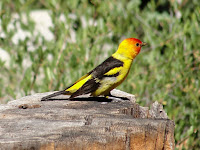WESTERN TANAGER
WESTERN TANAGER (Piranga ludoviciana) – (See images below)
DESCRIPTION: The Western Tanager Bird breeding male has a bright red head, face and throat. Upper back, wings and tail are black with yellow shoulders and rump. Under parts are yellow. Eyes are black. Conical bill, legs and feet are grey. Non-breeding male has less red markings. Female has an olive head, back and breast, with grey wings and tail. Wings have a whitish bar. Bird length is about 18 cm (7 inches).
VOICE: https://www.xeno-canto.org/species/Piranga-ludoviciana
NAME: ‘Tanager’ stems from ‘Tangara’, from Brazilian Tupi and refers to an unknown bird. Latin genus name ‘Piranga’ is also from Brazilian Tupi. Latin species name ‘ludoviciana’ means ‘of Louisiana’.
HABITAT: Coniferous or mixed forests, and also grassland or desert in the winter.
DIET: Insects gleaned from tops of trees or caught on the fly, seeds, berries.
NESTING: Nest is built usually high in a tree. Around three or four light blue-green eggs are laid, incubated by female. Young fed by both parents.
DISTRIBUTION: Breeding range covers western Canada up to the North West Territories and USA. During migration can be found east of that range, and also in the northern half of Mexico. Winters in southern Mexico and parts of Central America.
Distribution Map: https://en.wikipedia.org/wiki/Western_tanager – /media/File:Piranga_ludoviciana_map.svg
ON PEI: Does not breed on Prince Edward Island, sightings listed as ‘accidental’ so far. See note below on bird vagrancy.
CONSERVATION: Common and widespread, not at risk.
NOTES: This tanager species has the most northerly breeding range of its genus.
The Piranga genus used to be classified in the Tanager family, but now they have been moved into the Cardinal family, while still keeping the ‘Tanager’ name.
Vagrancy: In biology this means an animal going way outside its normal range. For birds, this can happen when there are storms and they get blown off course. On other times, the bird simply wanders in a different direction than usual. Here’s an article about vagrancy in birds.
SIMILAR SPECIES: Scarlet Tanager, Summer Tanager
REFERENCES: https://www.borealbirds.org/bird/western-tanager
http://identify.whatbird.com/obj/196/overview/Western_Tanager.aspx
American Bird Conservancy (Western Tanager)
http://www.nhptv.org/natureworks/westerntanager.htm (New Hampshire PBS)
http://fieldguide.mt.gov/speciesDetail.aspx?elcode=ABPBX45050 (Montana Field Guide)
https://animaldiversity.org/accounts/Piranga_ludoviciana/ (University of Michigan)
https://en.wikipedia.org/wiki/Western_tanager
https://txtbba.tamu.edu/species-accounts/western-tanager/ (Texas Breeding Bird Atlas)
https://birdatlas.mb.ca/accounts/speciesaccount.jsp?sp=WETA&lang=en (Manitoba Breeding Bird Atlas)
https://www.audubon.org/field-guide/bird/western-tanager
DESCRIPTION: The Western Tanager Bird breeding male has a bright red head, face and throat. Upper back, wings and tail are black with yellow shoulders and rump. Under parts are yellow. Eyes are black. Conical bill, legs and feet are grey. Non-breeding male has less red markings. Female has an olive head, back and breast, with grey wings and tail. Wings have a whitish bar. Bird length is about 18 cm (7 inches).
VOICE: https://www.xeno-canto.org/species/Piranga-ludoviciana
NAME: ‘Tanager’ stems from ‘Tangara’, from Brazilian Tupi and refers to an unknown bird. Latin genus name ‘Piranga’ is also from Brazilian Tupi. Latin species name ‘ludoviciana’ means ‘of Louisiana’.
HABITAT: Coniferous or mixed forests, and also grassland or desert in the winter.
DIET: Insects gleaned from tops of trees or caught on the fly, seeds, berries.
NESTING: Nest is built usually high in a tree. Around three or four light blue-green eggs are laid, incubated by female. Young fed by both parents.
DISTRIBUTION: Breeding range covers western Canada up to the North West Territories and USA. During migration can be found east of that range, and also in the northern half of Mexico. Winters in southern Mexico and parts of Central America.
Distribution Map: https://en.wikipedia.org/wiki/Western_tanager – /media/File:Piranga_ludoviciana_map.svg
ON PEI: Does not breed on Prince Edward Island, sightings listed as ‘accidental’ so far. See note below on bird vagrancy.
CONSERVATION: Common and widespread, not at risk.
NOTES: This tanager species has the most northerly breeding range of its genus.
The Piranga genus used to be classified in the Tanager family, but now they have been moved into the Cardinal family, while still keeping the ‘Tanager’ name.
Vagrancy: In biology this means an animal going way outside its normal range. For birds, this can happen when there are storms and they get blown off course. On other times, the bird simply wanders in a different direction than usual. Here’s an article about vagrancy in birds.
SIMILAR SPECIES: Scarlet Tanager, Summer Tanager
REFERENCES: https://www.borealbirds.org/bird/western-tanager
http://identify.whatbird.com/obj/196/overview/Western_Tanager.aspx
American Bird Conservancy (Western Tanager)
http://www.nhptv.org/natureworks/westerntanager.htm (New Hampshire PBS)
http://fieldguide.mt.gov/speciesDetail.aspx?elcode=ABPBX45050 (Montana Field Guide)
https://animaldiversity.org/accounts/Piranga_ludoviciana/ (University of Michigan)
https://en.wikipedia.org/wiki/Western_tanager
https://txtbba.tamu.edu/species-accounts/western-tanager/ (Texas Breeding Bird Atlas)
https://birdatlas.mb.ca/accounts/speciesaccount.jsp?sp=WETA&lang=en (Manitoba Breeding Bird Atlas)
https://www.audubon.org/field-guide/bird/western-tanager
 |
| Western tanager, OR, by Alan D. Wilson |
 |
| Western tanager female, Jerry Friedman |
 |
| Western tanager male, CA, Miguel Vieira |
 |
| Western tanager male, BC, by GregZ |